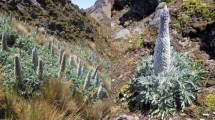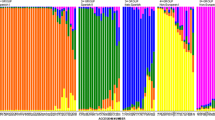Abstract
Open-pollinated seeds were assayed for allozyme polymorphisms at 24 loci to assess genetic diversity and multilocous associations in 16 populations of Cunninghamia lanceolata (Lamb.) Hook in the People's Republic of China. On average, the percentage of polymorphic loci was 88.0, the number of alleles per locus was 3.0, and the expected heterozygosity was 0.394. The distribution of genetic diversity was not correlated with the geographic and climatic variables of the populations. However, allele frequencies correlated linearly with the mean annual temperature of the populations at Mdh-1, Mdh-2, Mnr-2, Pgi-1, and Skdh-1 and with the altitude of the populations at Aph-4 and 6Pg-2. Of the total gene diversity 6% was attributed to among-population differentiation; 94% resided within populations. Two-locus gametic disequilibria were found in 15 of the 16 populations, and higher-order gametic disquilibria were significant in most populations. The gametic disequilibria did not correlate with geographic and climatic variables. The results suggest that population subdivision, founder effect, occurrence across diverse environments, a mating system dominated by inbreeding, and historical events from 2000 years of cultivation are contributing factors in the generation and maintenance of the multilocus genetic structure in this conifer.
Similar content being viewed by others
References
Baker RJ (1986) Selection indices in plant breeding. CRC Press, Boca Raton, Fla.
Boyle TJB (1985) The mating system and population structure of black spruce in central New Brunswick and its influence on tree improvement strategy. PhD thesis, University of New Brunswik, Fredricton, N.B.
Brown AHD, Feldman MW (1981) Population structure of multilocus associations. Proc Natl Acad Sci USA 78:5913–5916
Brown AHD, Feldman MW, Nevo E (1980) Multilocus structure of natural populations of Hordeum sponteneum. Genetics 96:523–536
Chen YW, Shi JS (1983) Some fundamental problems in the genetic improvement of Chinese fir. J Nanjing Inst For 4:1–21
Chen YW, Shi JS (1987) Genetic variation and improvement program of Chinese fir. J Subtrop For Inst 1:1–19
Fowler DP, Morris RW (1977) Genetic diversity in red pine: evidence for low heterozygosity. Can J For Res 7:341–347
Hamrick JL, Mitton JB, Linhart YB (1981) Levels of genetic variation in trees: influences of life history characteristics. In: Conkle MT (ed) Proc Symp Isozymes North Am For Trees For Insects. USDA For Serv Genet Tech Rep PSW-48, pp 35–41. Pacific SW Forest and Range Exp Stn, Berkeley, Calif
Karlin S (1978) Mathematical population genetics. Academic Press, New York
Kartz AJ, Enfield FD (1977) Response to selection for increased pupal weight in Tribolium castaneum as related population structure. Genet Res 30:237–246
Kendall MG (1947) The advanced theory of statistics, vol 1, 3rd edn. Charles Griffin, London
Lagercrantz U, Rayman N (1990) Genetic structure of Norway spruce (Picea abies): concordance of morphological and allozyme variation. Evolution 44:38–53
Li P, Adams WT (1988) Range-wide patterns of allozyme variation in Douglas-fir (Pseudotsuga menziesil). Can J For Res 19:149–161
Loveless MD, Hamrick JL (1984) Ecological determinants of genetic structure in plant populations. Annu Rev Ecol Syst 15:65–95
Müller-Starck G, Liu YQ (1989a) Genetics of Cuninghamia lanceolata Hook. 2. Genetic variation within and between two provenance samples. Silvae Genet 38:172–177
Müller-Starck G, Liu YQ (1989b) Inference on the reproductive system of Cunninghamia lanceolata. For Ecol Manage 29:187–198
Muona O (1982) Potential causes for multilocus structure in predominantly outcrossing populations. Silva Fenn 16:107–114
Mouna O, Szmidt AE (1985) A multilocus study of natural populations of Pinus sylvestris. In: Gregorius HR (ed) Population genetics in forestry. Springer, Berlin, Heidelberg New York, pp 241–252
Nei M (1973) Analysis of gene diversity in subdivided populations. Proc Natl Acad Sci USA 70:3321–3323
Roberds JH, Brotschol JV (1985) Linkage disequilibrium among allozyme loci in natural populations of Liriodendron tulipifera L. Silvae Genet 34:137–141
Xie CY, Dancik BP, Yeh FC (1992) Genetic structure of Thuja orientalis. Biochem Syst Ecol 20:433–441
Yang R-C, Yeh FC (1992) Genetic consequences of in situ and ex situ conservation of forest trees. For Chron 68:720–729
Yang R-C, Yeh FC (1993) Multilocus structure in Pinus contorta Dougl. Theor Appl Genet 87:568–576
Yeh FC (1989) Isozyme analysis for revealing population structure for use in breeding strategies. In: Gibson GL, Griffin AR, Matheson AC (eds) Breeding tropical trees: population structure and genetic improvement strategies in clonal and seedling forestry. Oxford Forestry Institute, Oxford, UK and Winrock Int, Arlington, Va., USA, pp 119–131
Yeh FC, El-Kassaby YA (1980) Enzyme variation in natural populations of Sitka spruce (Picea stichensis). I. Genetic variation patterns among trees from 10 IUFRO provenances. Can J For Res 10:415–422
Yeh FC, Layton C (1979) The organization of genetic variability in central and marginal populations of lodgepole pine Pinus contorta spp. latifolia. Can J Genet Cytol 21:487–503
Yeh FC, Morgan KM (1987) Mating system and multilocus associations in a natural population of Pseudotsuga menziesii (Mirb.) Franco. Theor Appl Genet 73:799–808
Yeh FC, O'Malley D (1980) Enzyme variation in natural populations of Douglas-fir, Pseudotsuga menziesii (Mirb.) Franco, from British Columbia. I. Genetic variation patterns in coastal populations. Silvae Genet 29:83–92
Yeh FC, Cheliak WM, Dancik BP, Illingworth K, Trust DC, Pryhitka BA (1985) Population differentiation in lodgepole pine, Pinus contorta spp. latifolia: a discriminant analysis of allozyme variation. Can J Genet Cytol 27:210–218
Author information
Authors and Affiliations
Additional information
Communicated by P. M. A. Tigerstedt
Rights and permissions
About this article
Cite this article
Yeh, F.C., Shi, J., Yang, R. et al. Genetic diversity and multilocus associations in Cunninghamia lanceolata (Lamb.) Hook from The People's Republic of China. Theoret. Appl. Genetics 88, 465–471 (1994). https://doi.org/10.1007/BF00223662
Received:
Accepted:
Issue Date:
DOI: https://doi.org/10.1007/BF00223662




